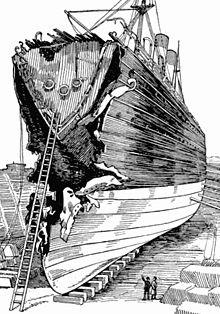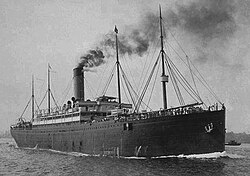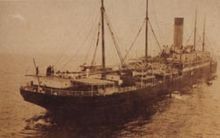RMS Republic (ship, 1903)
|
||||||||||||||||||||||||||
|
||||||||||||||||||||||||||
|
||||||||||||||||||||||||||
|
||||||||||||||||||||||||||
|
||||||||||||||||||||||||||
The RMS Republic (II) was a passenger ship put into service in 1903 by the British shipping company White Star Line .
In the early morning of January 23, 1909, the Republic collided south of the island of Nantucket in thick fog with the Italian passenger ship Florida . While the Florida managed to stay afloat, the Republic sank on the evening of the following day. With the exception of the six people who were killed directly in the collision, over 1,500 people were brought to safety by both ships. To this day, this person transfer on the open sea is one of the largest rescue operations that have ever taken place.
Nevertheless, the sinking of the Republic caused violent reactions, as it was the largest British steamship to have crashed to date. In connection with the accident, an " FT emergency call " was sent for the first time in a ship accident using the new communication technology of maritime radio via radio telegraphy and thus help was requested.
The sinking of the Andrea Doria in 1956 showed parallels with regard to the location and circumstances of the collision.
The ship
The 15,358 GRT steamship was built at the Harland & Wolff shipyard in Belfast for the British steamship company Dominion Line , which was part of the American group International Mercantile Marine Company (IMMC). Before being launched on February 26, 1903, the ship was christened Columbus . After its completion on September 12, 1903, the Columbus ran on October 1, 1903 on the route Liverpool - Boston - Queenstown on her maiden voyage .
The wood paneling of the first class dining room, which was crowned with a glass dome and could accommodate 200 people, was decorated with ornaments . There was also a smoking room, a library and a lounge adjacent to the promenade deck . Very expensive materials were used in the cabins and common rooms.
After only two trips for the Dominion Line, the British shipping company White Star Line, which also belongs to the IMMC, bought the Columbus . After being renamed Republic , White Star initially used the ship for the Liverpool – Boston route, on which it made its first voyage on December 17, 1903. From January 1904 the Republic was also used in the Mediterranean service, with Naples and Genoa being the ports of destination. She often drove wealthy Americans to Europe who wanted to go on vacation in the Mediterranean climate , while on the western passages to the USA mostly southern European emigrants were on board.
From October 1904 until her demise, she alternated between two routes: in spring and summer she steamed from Liverpool to Boston and in autumn and winter she drove from New York to the Mediterranean. Almost two years before her sinking, the Republic was already involved in a collision with another ship when it collided with the Italian steamer Centro America on February 16, 1907 in the port of Naples . Nobody was injured, but both ships were damaged.
The last ride
beginning of the journey
The Republic set off from Pier 48 of the White Star Line on Friday, January 22, 1909, at 3:00 p.m. in New York City for a regular Atlantic crossing to Naples via Madeira . She had made her last trip east on January 13th. 250: On board were 742 people were passengers of the first class, 211 passengers of the third class and 281 crew members. Second class was not occupied on this trip. The ship was under the command of the 46-year-old Captain William Inman Sealby, who had been the skipper for 13 years. The freight included five tons of American Gold Eagle gold coins with a value of three million US dollars ($) at the time, gold and silver bars, pay books for the Royal Navy and a large number of documents from John Pierpont Morgan .
The First Class passengers included many prominent figures of the time, including:
- General Brayton C. Ives, American railroad entrepreneur and financier , President of the Metropolitan Trust Company
- John Merle Coulter , American scientist , botanist, and author ( Plant Genetic ) with wife and children
- James Connolly , Olympic champion in the triple jump
- Samuel Cupples, philanthropist, entrepreneur, and multimillionaire from St. Louis with daughter and three granddaughters
- Rev. Thaddeus Alexander Snively, pastor of St. John's Episcopal Church in Troy, New York
- Rev. John W. Norris, pastor of St. Peter's Church, New Brunswick, New Jersey ( appointed prelate by Pope Benedict XV in 1919)
- Jean F. Whiting, American tennis player , daughter of manufacturer John Hill Whiting (founder of the Detroit Foundry Equipment Company)
- Mildred Montague, Countess Pasolini, daughter-in-law of the former Italian Senate President Giuseppe Pasolini
- Bessie Armstead Davis, daughter-in-law of US Senator Henry G. Davis with two children
- Alice Morse Earle , American historian and biographer
- Sophie Mansfield Curtis, wife of the Author and Treasurer of the International Silver Company George Munson Curtis
- Mary Harriman Severance, wife of prominent lawyer and entrepreneur Cordenio Severance from Minnesota
- Julia Sherman Wakefield, wife of genealogist Homer Wakefield ( The Wakefield Memorial , 1897)
Also on board was a larger tour group who had booked the two-month foreign excursion “Tours To The Orient” organized by the Thomas Cook and Son travel agency. The group, led by tour guide William Solboch, was to disembark in Alexandria and take an extended tour of the Middle East. The Republic's timetable was as follows: first stop in Ponta Delgada in the Azores on January 29, arrival in Gibraltar on February 2, in Genoa on February 5, in Naples on February 7 and in Alexandria on February 11 . She was expected to return to New York on February 25, 1909.
Collision with the Florida

In the early morning of January 23, 1909, the Republic steamed about 50 nautical miles southwest of the island of Nantucket off the coast of the US state of Massachusetts out of sight through thick fog . Captain Sealby put the engine room on alert and sounded the foghorn at regular intervals to indicate his presence to other ships. The speed of the ocean liner was only reduced minimally. The ship was about 175 miles east of the Ambrose Lighthouse.
At 5:47 a.m. the crew on the bridge heard the fog horn of another ship on port ahead. Sealby gave the commands "engine back to full power" and "rudder hard port", but it was too late. Suddenly a ship appeared out of the fog, ramming the much larger Republic on port amidships at almost a right angle. It was the passenger steamer Florida (5,018 GRT) of the Italian shipping company Lloyd Italiano , which was commissioned in 1905 and was on its way from Palermo to New York.
As a result of the collision, three crew members were killed on the Florida who were in the forecastle . The bow of Florida was up to the first watertight collision bulkhead compressed. Two First Class passengers were killed on the Republic : Mary Lynch, wife of the Boston liquor wholesaler Eugene Lynch and the banker William J. Mooney from Langdon, North Dakota . Eugene Lynch was seriously injured and died on January 26 at Long Island College Hospital in Brooklyn . In addition, many passengers were injured. In a few minutes machine and ran boiler rooms of the Republic full control and electricity supply fell out, and the ship began a considerable list to get.
With the reserve batteries, Republic radio operator Jack Binns was able to use spark telegraphy to send an " FT emergency call " with the Morse code CQD - the character string SOS was only established later - and thus request help. It was the first time in the history of shipping that a ship in distress used the CQD signal to ask for help. Although the CQD was received by various ships, it was difficult to find the Republic in the thick fog. Captain Sealby, assuming that his ship would not sink, had the passengers ordered on deck and announced that help was on the way. He also had drinks and blankets distributed. Initially, the ship was not evacuated.
Salvation and destruction
The Republic's survivors had to wait 13 hours for rescue after the collision of their ship. The first ships at the site of the accident were the Gresham , a small coast guard cutter and the destroyer Seneca . They picked up some of the Republic's passengers . Most of the castaways , however, were transferred to the Florida , which was damaged but still buoyant. The small liner was quickly overcrowded as it already had over 900 Italian emigrants on board who had survived the great Messina earthquake the previous December .
Only when the White Star Liner Baltic arrived under the command of Captain Joseph B. Ranson in the evening , both the passengers already handed over to the Gresham and all those still on board the Republic were taken over. Since there was a risk that the affected Florida would not reach New York City safely, the Baltic also took over its passengers. There was almost a commotion as the Italian emigrants were outraged that the Republic's first -class passengers were taken on board first. After everyone was on board, the Baltic brought the rescued to New York City.
Only a small group of crew members, led by Captain Sealby and Second Officer RJ Williams, remained on board the leaky Republic . Little by little, other ships such as the City of New York passenger liners of the Inman Line and Lucania of the Cunard Line arrived at the site of the accident. Attempts were made to moor the Republic and bring it to shallower waters where it should run aground. This failed, however, and the ship went down about 39 hours after the collision on January 24 in the evening at around 20:40. Sealby and the rest of the crew were rescued beforehand and also brought to New York.
Rumors about the cargo
Shortly after the disaster, rumors began to circulate about the ship's cargo, some of which still exist today. The White Star steamer carried 15 tons of gold bars and American gold coins for the Great White Fleet of the US Navy on board. According to other sources, donations from an aid fund for the victims of the Messina earthquake are said to have been part of the cargo. Recent theories include the claim made by the discoverer of the wreck of the Republic , Martin Bayerle, that $ 1 million in gold coins should go to Tsarist Russia as part of a $ 240 million loan.
The monetary figures refer to the value in 1909. According to today's money, the commodity, if it were actually composed as claimed, would be worth several hundred million dollars. Experts estimate that selling the coins could fetch close to five billion dollars. The recovery of the Republic would be the biggest maritime treasure find in history.
Localization and rescue attempts
The Republic wreck was found in 1981 by Captain Martin Bayerle. It lies upright at a depth of about 80 meters. In the 1980s, there were two salvage operations aimed at finding the gold . Both expeditions failed and the gold has not yet been discovered. In 2005, the Massachusetts Court of Justice upheld Martin Bayerle's sole right of recovery. In 2007 he had expert examinations carried out on the wreck and planned another rescue attempt for the summer of 2008. The wreck of the Republic was to be dismantled into sections and these should be recovered one after the other. However, these plans could not be brought to a successful execution and in January 2013 Bayerle suffered a setback when a lawsuit for the publication of precise plans for the ship failed. Nevertheless, he has not given up the plan of a rescue and wants to finance further operations from media sales.
Footnotes
- ↑ Adjusted for inflation , $ 3 million is roughly $ 100,000,000 today. This figure was based on the template: Inflation determined, rounded to a full million US dollars and relates to last January. At the current exchange rate it would be around EUR 263 million. This figure was determined using the template: Exchange rate data / ECB .
- ↑ The Boston Herald: Hunt for gold on Titanic sister ship grounded by ruling
- ^ The Martha's Vineyard Times: A billion dollar treasure: The answer is waiting off Nantucket
literature
- Robert D. Ballard , Ken Marschall : Lost Liners - From the Titanic to Andrea Doria - the glory and decline of the great luxury liners . Wilhelm Heyne Verlag GmbH & Co. , Munich 1997, ISBN 3-453-12905-9 (English: Lost Liners: From the Titanic to the Andrea Doria. The ocean floor reveals its greatest lost ships. Translated by Helmut Gerstberger).
Web links
in English:
- Website rms-republic.com
- Illustrated report with a focus on radio emergency calls
- "The Triumph of Wireless" (Report on the course of events in The Outlook magazine , February 6, 1909)
- Article about the Republic on Cyber Diver News Network (CDNN)
- Blog post on a website about shipwrecks and diving
- Information on Captain Inman Sealby
- The Republic's cargo
- Passenger list of the last trip

